
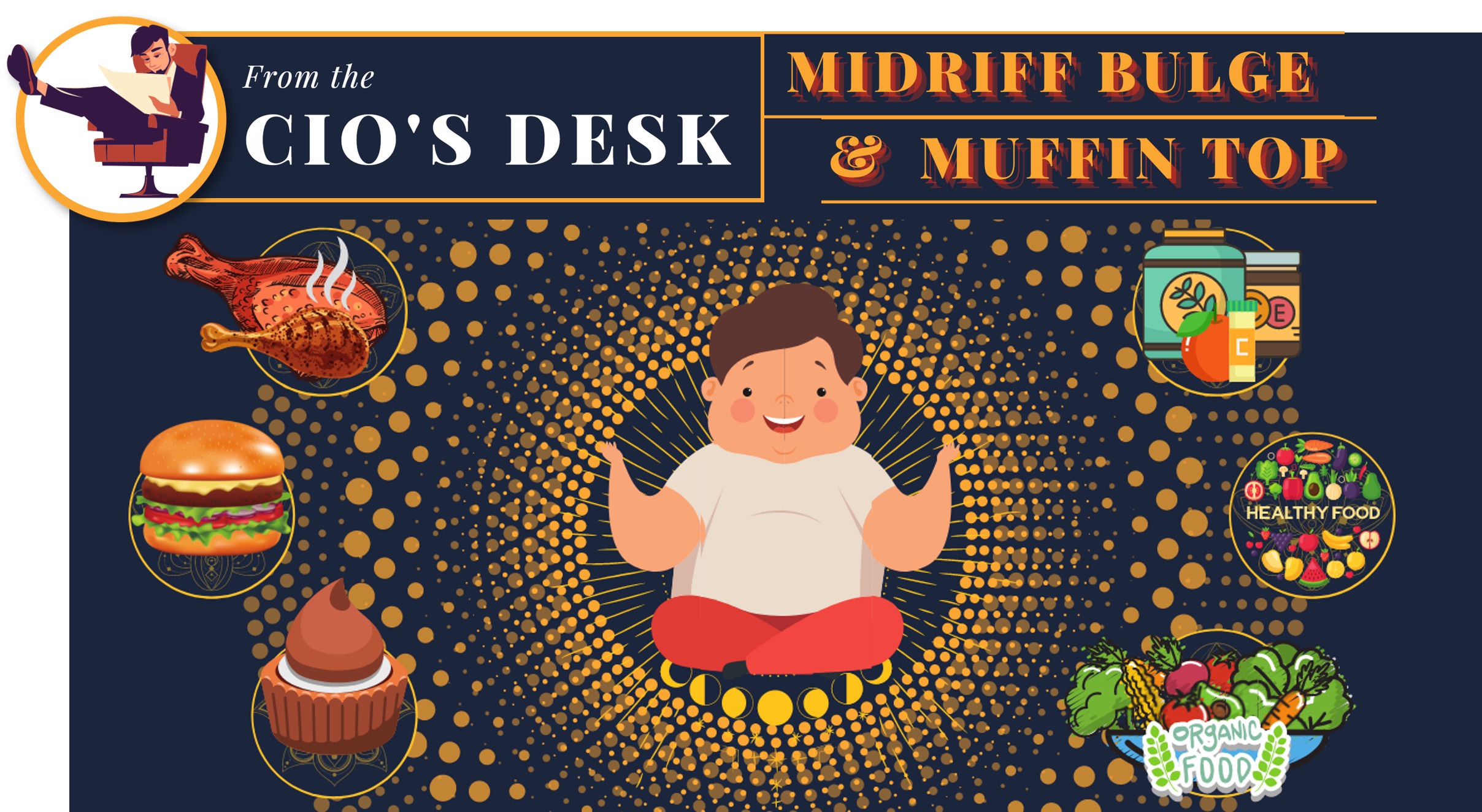
I would like to make a confession: I am not distinctively physically attractive. After two years of secret denial, I have to admit the fact. When friends and family ask me what is my favourite body part (you could imagine what we talk about during Zoom hangouts), I’d habitually, though unconvincingly, respond that it is the eyes: not for how they look, but for how they see. I have to admit that my midsection is not an attractive sight. No matter how many sit-ups I perform at home, there is no six-pack there, or anywhere in the vicinity. I cannot even get a one-pack going. I blame this on multiple lockdowns which have forced gym to close, although I secretly think that is because so many packs of teh tarik made their way downstream over this course of two Covid-19 years as I recreated the experience of ‘hang-out-at-mamak’ from the comfort of my home.

In any case, not being able to avoid seeing my spare tire, I take my friend’s advice when it comes to weighing himself: do it only (emphasis added) first thing in the morning. His rationales are (i) first, commitment (there is an element of ultimate fascination); (ii) second, tactical (there is the additional appeal of lights being dim and my eyes remain blurry when I wake up); and (iii) lastly, circumstantial (if I can creep past the bathroom looking glass while turning my head the other way, then all the better). For the record, my friend has lost his office’s weight-loss challenge, and I should be wary of his advice regardless of how “wise” it may sound.
Another friend of mine has kindly suggested that I should substitute teh tarik with vegetable juice. It is neither my style nor can I imagine being able to drink it down with a smile. Being ever-fashionable, she reasons that it is much more pleasant to drink the green juice than the Gaviscon laxative I may have to gulp after bouts of overeating acid reflux.
I am sure some of you have experienced this ‘pandemic weight-gain’. I’ve put on a few kilos during quarantine. I tended to move less during the prolonged periods of lockdown, with emotional eating and gym closures intensifying the course.

One of the visible trends coming out of Covid-19 is that a significant amount of people want to go back to a pre-pandemic weight as a major personal health goal. Generally, people have become more health and wellness aware, and this newly adopted trend has impacted consumer choices, especially their food choices. That demand for healthier food can be seen in the way poke bowls, salad stations and juice bars in the city are eating away at the fast-food market. Healthy snack food start-ups including Signature Market have seen an impressive growth and reaped value from a healthy eating trend as we ease our way out of the pandemic.

The convergence of demographic, lifestyle and technology trends will also shape the direction of food’s future. We have seen more and more innovative start-ups to challenge the way food is produced and distributed on top of disrupting how food is consumed. Start-ups such as FeFiFo aim to fundamentally change how smallholder farmers grow our food and raise productivity through technology adoption. Once produce is harvested and livestock slaughtered, food goes through a supply chain whose system remains archaic. Start-ups like Glife Technologies seek to optimise the logistics and fulfilment services required for distributing food while Food Market Hub strive to digitalise the procurement processes. Currently focusing on B2B market and F&B businesses, Food Market Hub help to shorten food supply chain through their online platform, integrated procurement as well as inventory management, and smart logistics. Innovative start-ups are poised to revolutionise and restructure supply chain as we rethink our approach to food reliability.
Covid-19 also highlights the interrelations between our natural and societal systems. Societal resilience depends on a resilient environmental support system. Lack of protection on biodiversity and food systems makes zoonotic diseases more likely. Sustainability advocates have argued the lower greenhouse gas emissions from plant-based meat and milk production point the way to a new high-tech, animal-free approach to food and drink that could help feed humanity as well as curb global warming. We anticipate the growth of alternative protein start-ups such as Growthwell to accelerate and lead a new way forward for the food sustainability, driven by latest breakthroughs in food science and shifts in consumer tastes towards products seen as healthier and more sustainable.
In order to improve the health of our society, we must invest and work towards building thriving future-ready food system, while protecting our environment for generations to come. Having not taken care of our health and environment for years, we should not lose fresh hope and put up with unsightly cellulite, unexpected cardiac arrests and undesirable future.


We have heard the age-old saying time and time again. The saying was originally coined by Anthelme Brillat-Savarin in 1826, albeit in a different language and tone, however carrying the same meaning. What we consume has been an important factor since eons ago despite the lack of technology and accessibility to cater to each individual dietary needs.
Over the decades, our food journey has changed and developed in order to satisfy our needs and behaviours. This industry is characterised by a complex system of activities concerning supply, consumption and delivery of food products across the entire globe. In the 21st century, we can see how dietary needs and natural events led the change in the industry.
Catalyst of Change


It is said that in 50 or 100 years down the road, we will be eating food in the form of pills, powders and liquid only, served and perhaps, cooked by a robot, as that would be the only thing that the human body needs, in the addition to limiting the harm to the environment. The question is, are we willing to go to that extreme? On the opposite side of the spectrum, we have a community of food lovers who believe that food is a lifestyle rather than just a necessity i.e., properly cooked with that dash of sugar and spice to tingle the taste buds.
Enter FoodTech
To cater to the ever-evolving industry and satisfying the consumer’s needs, producers, chefs and restaurant owners must innovate around the new macro trends to ensure the sustainability of their business. With FoodTech, the food industry players can capture high potential cohorts, especially millennials as well as being able to ensure food sustainability within the country is well maintained.
FoodTech, a fusion of the words ‘Food’ and ‘Technology’, is an emerging sector that aims to improve the production, preservation, quality control, research and development as well as sustainability of food products by leveraging on technology. FoodTech encompasses a wide range of solutions that could potentially disrupt how our food is sourced, prepared, processed and delivered – from farm-to-fork.
The global FoodTech sector has seen tremendous trajectory over the past few years and is projected to reach a value of USD342.52 billion by 2027, according to recent analysis by Emergen Research. This can be attributed to various factors such as an increasing adoption of advanced technologies and automation in food processing techniques, rising concerns over the environmental impact of the food industry, regulatory requirements for greater transparency across the food value chain and many more.
The traction for FoodTech startups is also evident in the venture capital (“VC”) space. The United States (“US”), home to the world’s top FoodTech start-ups including the likes of Impossible Foods, Beyond Meat and Ordermark, has seen an influx of investments into FoodTech. This uptrend could very well continue as traditional food companies explore strategic or commercial partnerships with FoodTech startups via their corporate VC arms.
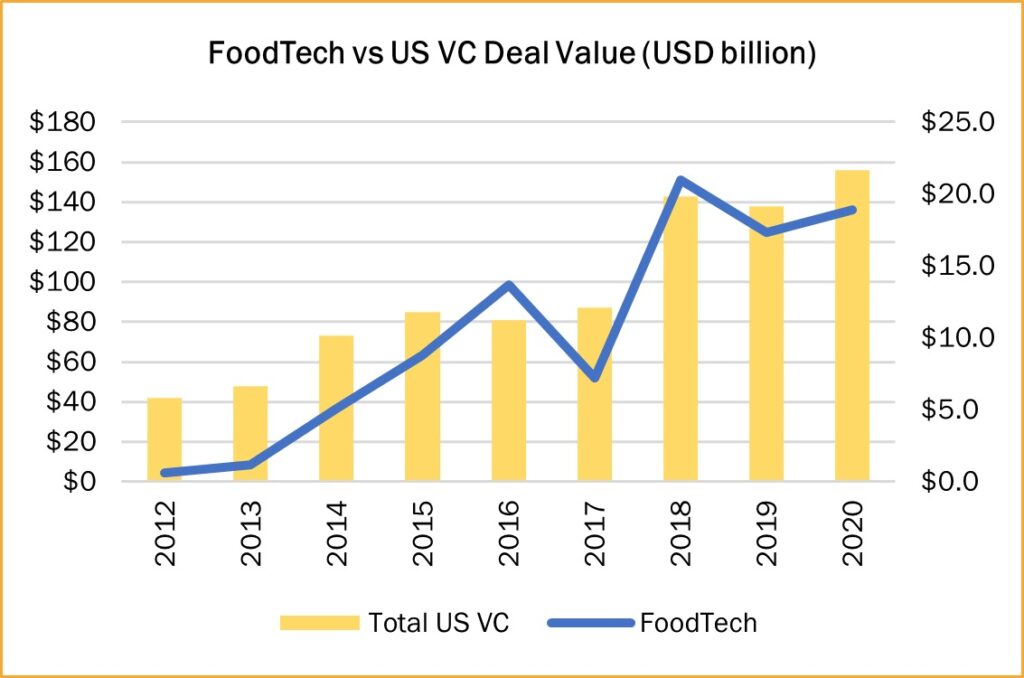
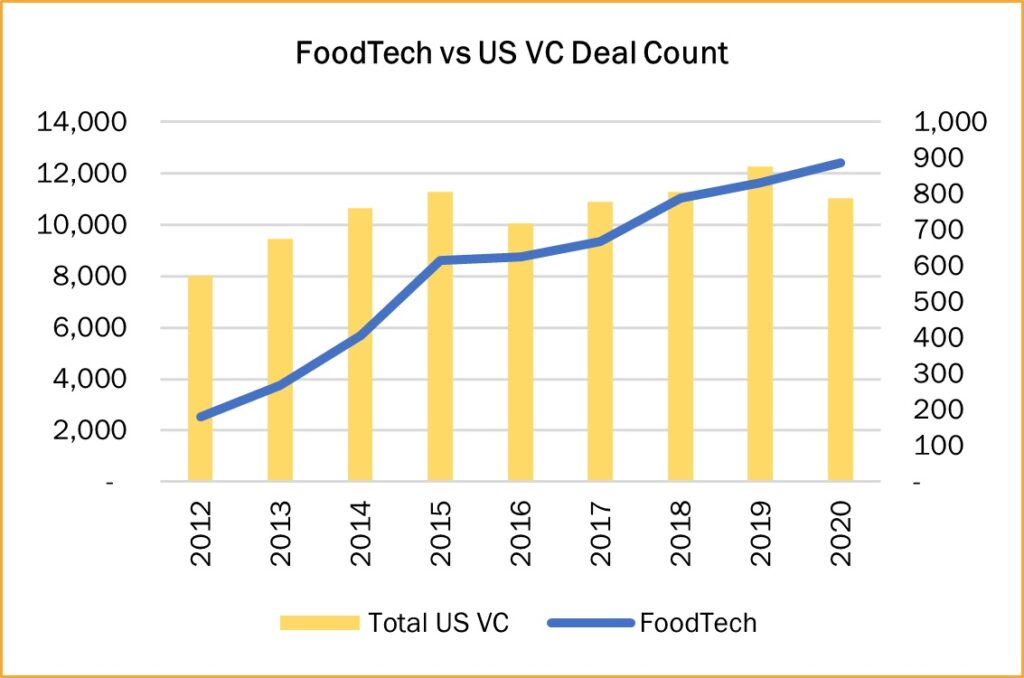
Source: NVCA, Pitchbook
Alternative Meat – Meat or No Meat?
While the FoodTech sector is undoubtedly sizeable and covers a lot of aspect in the food industry, one trend that has seen strong interest is alternative meat. The idea of plant-based meat might sound foreign to some but where there is demand, there is supply. As consumers demand for more sustainable and personalised food choices, we could potentially see this trend continue. On the supply side, climate change, for instance, has impacted harvests in various parts of the world, hampering food supply especially to the poor who, unfortunately, heavily depend on traditional agriculture and livestock. In fact, the United Nations have come out with a statement saying food production must double by 2050 to meet the demand from the world’s growing population. Therefore, there must be alternative sources to ensure that the food security issue is properly mitigated.
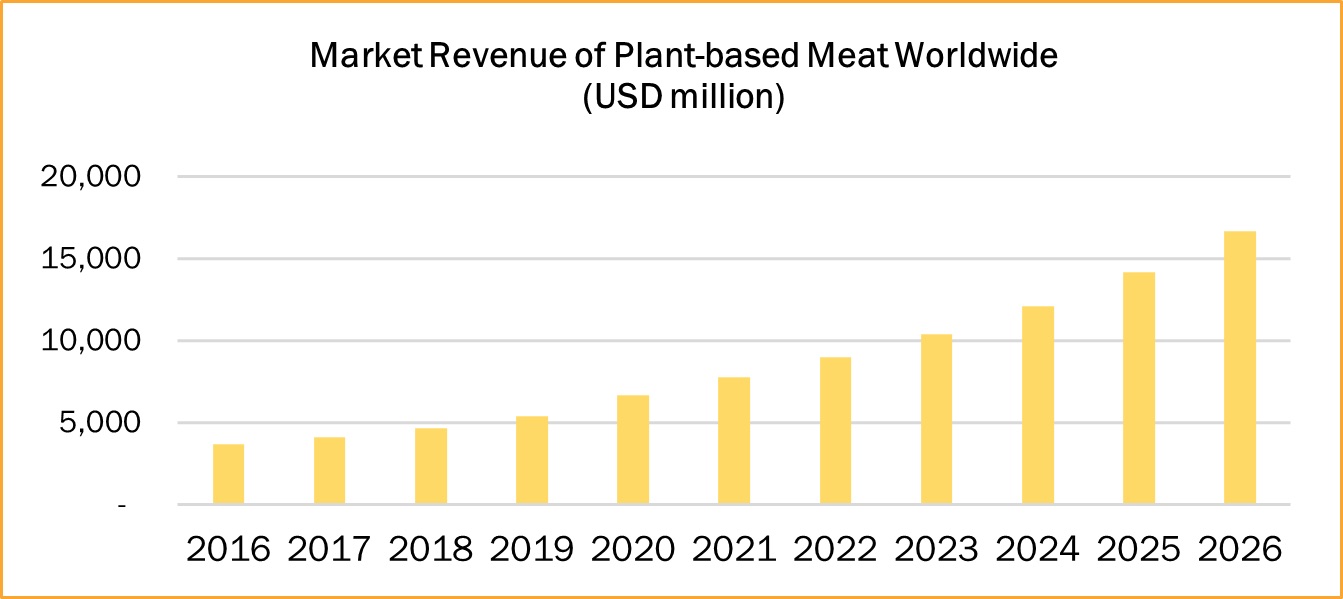
Of course, there is still a long way to go before alternative meat can become a significant part of everyone’s diet. Challenges faced by alternative meat startups include:
| Taste | – | Alternative meat must be able to replicate the smell and taste of traditional meat. |
| Texture | – | Alternative meat must look and feel the same as their traditional counterparts. |
| Price | – | Alternative meat must be competitively priced compared to traditional meat before it can create significant demand. |
| Trust | – | Consumers must take comfort in knowing that alternative meat is safe to consume. |
However, as technological developments in the alternative meat industry mature and economies of scale is achieved via high-volume productions, alternative meat could easily complement or even replace traditional meat in our daily consumption. As for trust, regulators need to play a role in enforcing high safety standards and promote manufacturing transparency before alternative meat can penetrate the mass market.
What the Future Holds
While alternative meat may be the current buzzword, the FoodTech industry encompasses other aspect too such as food waste reduction, digital food management, food e-commerce and many more. In July 2021, we saw Softbank made its first investment in the Middle East region through its Series C investment in Kitopi, a Dubai-based cloud kitchen start-up, amounting to USD415 million. This represents the largest ever financing rounds raised by a venture-backed company in the region.
What we want to highlight is how a traditional industry is changing, once again, to cater to the growing needs of the consumers as well as the technology evolution. Below is the Top 10 FoodTech trends that are currently making the global headlines. It won’t be long before this technology evolution becomes mainstream.
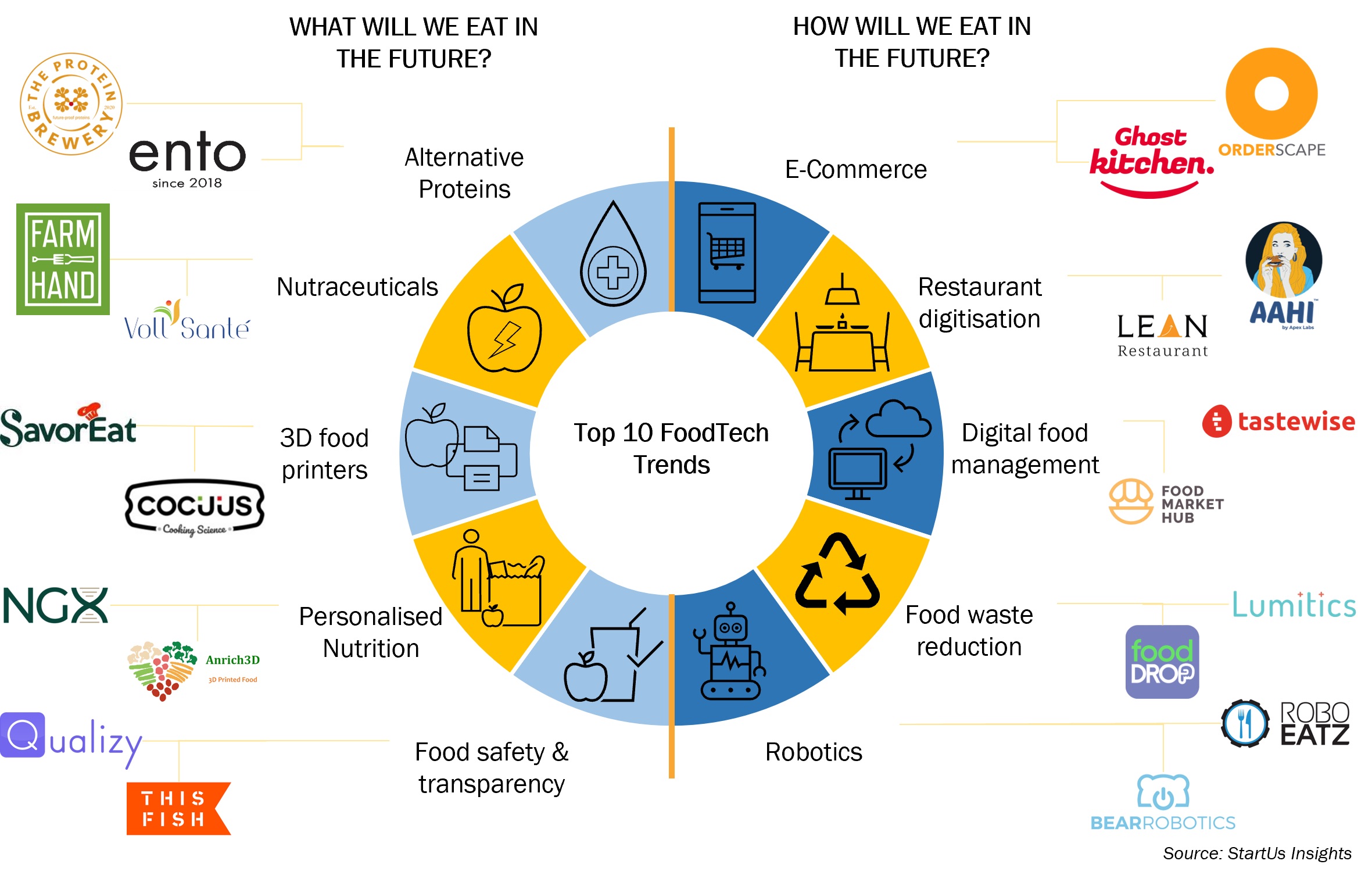

Digitalising F&B Using Big Data & Analytics
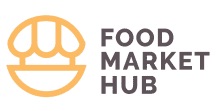
Market Context
The global Food and Beverage (F&B) industry is expected to grow to USD6.1 trillion in 2020 from USD5.9 trillion a year earlier although the world was grappling with the Covid-19 pandemic and a global health crisis. As more economic sectors are allowed to reopen and we move beyond pandemic to an ‘endemic’ economy, F&B sector is expected to recover and grow at a CAGR of 7% from 2021 and reach USD7.5 trillion in 2023. In terms of market share, Asia Pacific has the largest market share in the global F&B market at 42% in 2019. North America was the second largest region accounting for 22% of the global market in terms of value.
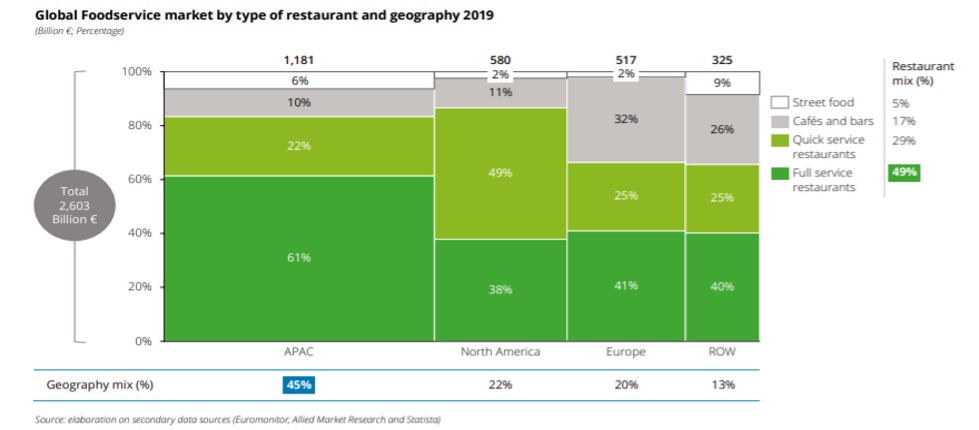
The F&B market can be divided into two equal segments of food retail and food service. The global food retail segment has a market size of USD2.8 trillion, Deloitte has estimated that the global food service has a market size of USD3.1 trillion in 2019, with Asia Pacific representing almost half of the total market.
Problem Statement: Disorganised, High Wastage and Complex
F&B procurement has traditionally been very messy and disorganised. Restaurants are slow to digitalising their operations: they have no centralised system to track and organise their orders. Moreover, purchasing process in the F&B industry is still very manual, mostly performed via phone calls or messaging apps. As inventories are not tracked, the F&B industry has poor inventory management with outdated practices which lead to high wastage from over-ordering supplies. This leads to time wasted on manual data input as restaurants procure their supplies.
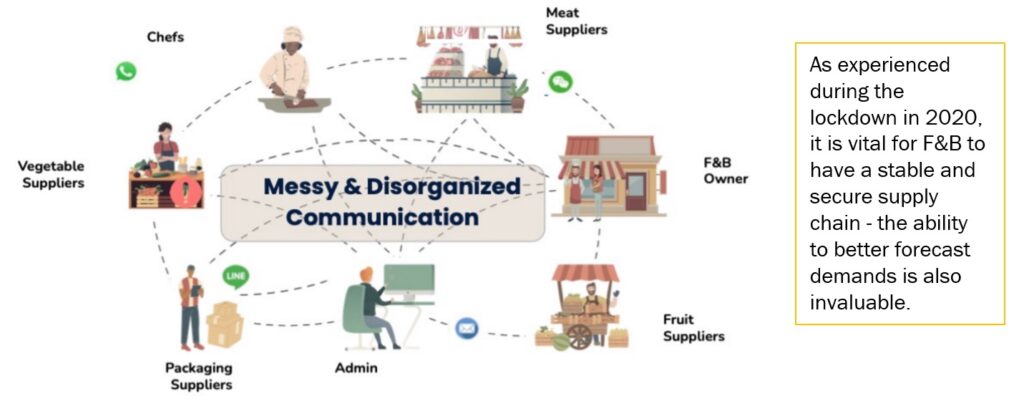
Solution
FoodTech could be the answer to F&B food wastage, messiness and disorganised problem. With the new technology advancement, F&B owners can invest to improve their effective returns by reducing food wastage, be more coordinated and able to forecast inventory level. This presents an opportunities for start-ups to enter the space with the goal of simplifying the supply chain from farm-to-fork.
Who is Food Market Hub
Food Market Hub is a Malaysian-based SaaS procurement management system and a B2B marketplace in the F&B industry, focusing on restaurants that are growing into chains or franchises. Founded in 2017, it aims to reinvent the food supply chain industry as an efficient and transparent ecosystem. Food Market Hub’s SaaS solution has five main features that help restaurants digitised the F&B procurement process. These are ordering and receiving (handling all purchases in one place), digitalising documents, inventory management, business intelligence like monitoring insights such as food cost and price change, to open loop messaging. This will allow users to manage all their supplier-related communication in a single app and vice versa. In turn, this will help users to streamline and reduce wastage and in turn increase their profit margin. Food Market Hub has successful raised USD12.5 million in its Series A round from reputable venture capital (“VC”) firms, which include Go-Venture (the VC arm of Indonesia first decacorn Go-To), Penjana Kapital’s SEA Frontier Fund (managed by AC Ventures, one of the recipients of Dana Penjana Nasional) and SIG. It is already used by the big players such as Din Tai Fung, Paradise Group, myBurgerlab and Rhombus Connexion.
The Future of Food Market Hub
The start-up provides complementary inventory and procurement solution given that it integrates well with existing practices such as email orders and mobile messaging platforms. As more and more restaurants undertake digitalisation, Food Market Hub sees a high retention rate – the pandemic uncovered the need to digitalise food supply chain and transition towards sustainable and resilient food system. By having an asset light business model, Food Market Hub can focus on simplifying procurement process rather than serving the procurement service itself. With AI and big data gets more developed, its users can focus on their F&B business while Food Market Hub manage their food costs, reduce waste level and optimise operations.
The newly raised capital will be used to support Food Market Hub’s expansion in Indonesia and Thailand, two of the largest markets for restaurants in Southeast Asia. This will allow them to tap into new markets and scale up. Food Market Hub also plans to solidify its offerings by venturing into contractual marketplace and supply chain financing. This will allow smaller and independent restaurant operators with limited financial resource and low bargaining power to compete with larger restaurant operators.
Something to keep in mind
Food Market Hub has market presence in Malaysia, Singapore, Thailand, Hong Kong and Taiwan. With strong support from reputable regional VCs in their existing cap table, it is on track to scale and succeed.

Many do not know this, but reception for our maiden event Capital Connections (featuring Carsome’s CEO, Eric Cheng) in September 2021 was a pleasant surprise to the team. Despite being an online-only private event, participants were engaged, and the Q&A session was robust and interactive. The main gripe participants had was – the event was too short.

Flattered but not contented, the team brainstormed and planned for a bigger, better and more ambitious second iteration of our flagship event – a physical event with an esteemed speaker from overseas, and invitations will be extended to industry leaders outside of Penjana Kapital.
With that in mind, we joined forces with our valued Dana Penjana Nasional’s VC Partner, AC Ventures with a theme not unlike the previous event – with a slight twist, micro-mobility.
Enter Beam Mobility
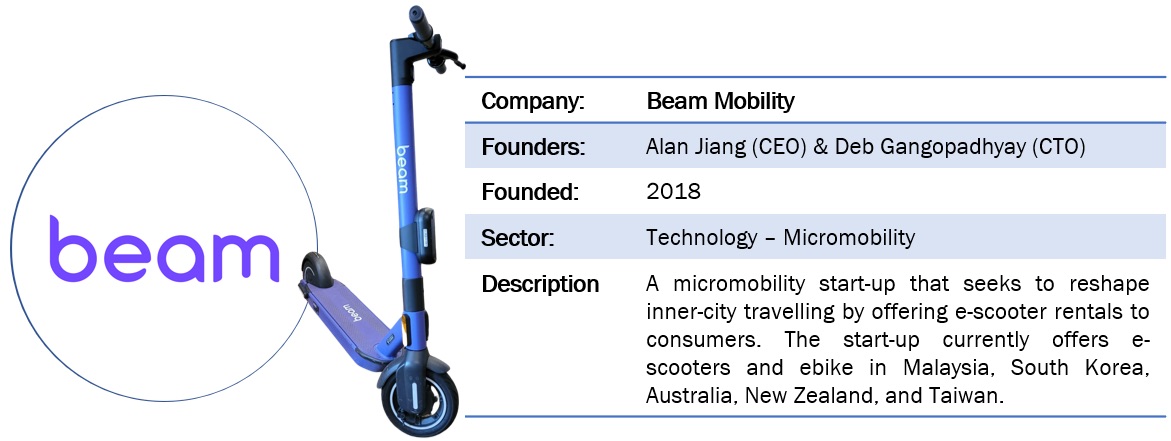
From Uber to Founding the Largest Shared Micromobility Operator
An Economics graduate from Yale, Beam Mobility’s CEO, Alan Jiang spent more than four years in a leading position with Uber and ofo before conceptualising the largest e-scooter start-up in Asia Pacific region.
Within the span of three years, Beam continues to innovate and enhance their fleet; navigating the business through different regulations in multiple countries.

e-Invitation sent out to our esteemed Board of Directors, Investment Panel members and external industry leaders

Alan Jiang, CEO of Beam Mobility

Beam scooters takes centre stage before CEO Alan Jiang’s Fireside Chat Session

Connecting Great Ideas with Great Funders
This was the first Capital Connections open to selected external parties such as regulators, potential investors and VC partners. Participants however were limited to only 35 (including staffs and AC Ventures team) to comply with Covid-19 SOPs.
Nevertheless, Alan and Beam Director Isabelle Neo brought with them 2 e-scooters with the help of Beam Ranger, Hafiz to showcase Beam’s ingenuity and technology capability. Unlike our previous event, presentation was kept short to make way for a longer Q&A session – which was a huge risk as some team members opined that Beam’s visibility is less prevalent in Malaysia. Nightmares of pin drop silence during our event was the reason we tasked our analysts to pre-prepare questions.
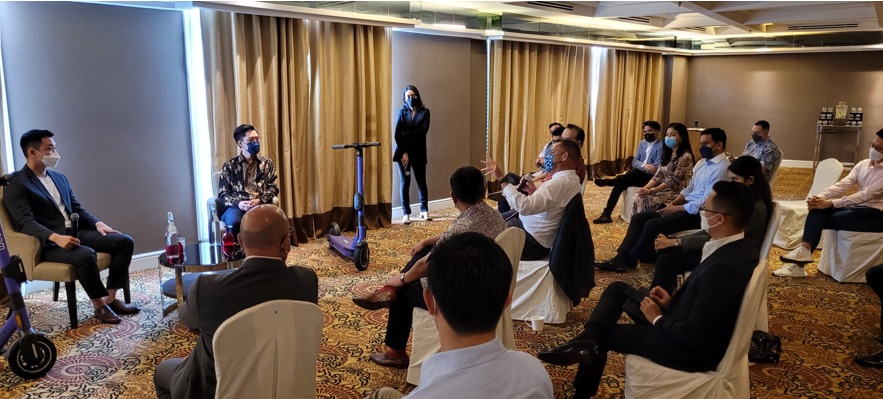
| Highlights of the event could be found on our Capital Connection Showcase Page on LinkedIn including interesting bits from the Q&A session as well as candid photos of the Penjana Kapital, AC Ventures team, and of course Beam Mobility’s CEO Alan Jiang. |



| DISCLOSURES AND DISCLAIMER |
This Newsletter is strictly informational and is issued Penjana Kapital Sdn Bhd (“PKSB”) on the basis that it is only for the information of the particular person to whom it was provided. This document may not be copied, reproduced, distributed or published by any recipient for any purpose unless Penjana Kapital Sdn Bhd’s prior written consent is obtained. This newsletter has been prepared for information purposes only and is not intended as an offer to sell or a solicitation to buy any securities, and/or any other product in Public or Private markets. Penjana Kapital Sdn Bhd is not making any recommendation to buy any securities or other product and the information provided should not be taken as investment advice.
It has been prepared without regard to the individual financial circumstances and objectives of persons who receive it. Penjana Kapital Sdn Bhd has no obligation to update its opinion or the information in this newsletter and Penjana Kapital Sdn Bhd recommends that you independently evaluate particular investments and strategies and seek the advice of a financial adviser prior to entering into any transaction. The appropriateness of a particular investment or strategy will depend on your individual circumstances and objectives. The information herein was obtained or derived from sources that Penjana Kapital Sdn Bhd believes are reliable, but while all reasonable care has been taken to ensure that stated facts are accurate and opinions fair and reasonable, we do not represent that it is accurate or complete and it should not be relied upon as such. All opinions and estimates included in this newsletter constitute our views as of this date and are subject to change without notice.
Penjana Kapital Sdn Bhd is not acting as your advisor and does not owe any fiduciary duties to you in connection with this newsletter and no reliance may be placed on Penjana Kapital Sdn Bhd for advice or recommendations of any sort. Nothing in this newsletter shall constitute legal, accounting or tax advice, or a representation that any transaction or investment is appropriate for you taking into account your investment objectives, financial situation and particular needs, or otherwise constitutes any such advice to you. Penjana Kapital Sdn Bhd makes no representations or warranties, express or implied, with respect to the accuracy of the information or fitness for any particular purpose and does not accept any liability (including but not limited to any direct, indirect or consequential losses, loss of profits and damages) for any use you or your advisors make of the contents of this newsletter or for any loss that may arise from the use of this newsletter or reliance by any person upon such information or opinions provided in the newsletter. This newsletter has been prepared by the analysts of Penjana Kapital Sdn Bhd. Facts and views presented in this newsletter may not reflect the views of or information known to other business units within Penjana Kapital Sdn Bhd. This information herein is not intended to constitute “research” as it is defined by applicable laws. This newsletter is not directed to or intended for distribution to or use by any person or entity who is a citizen or resident of or located in any locality, state, country or other jurisdiction where such distribution, publication, availability or use would be contrary to law or regulation. The information provided in this document has been obtained or derived from sources believed to be reliable. Penjana Kapital Sdn Bhd does not guarantee its accuracy or completeness and does not assume any liability for any loss that may result from the reliance by any person upon any such information or opinion. Such information or opinions are subject to change without notice, are for general information only and is not intended as an offer to sell or a recommendation/ solicitation to buy any securities, foreign exchange or other product.
